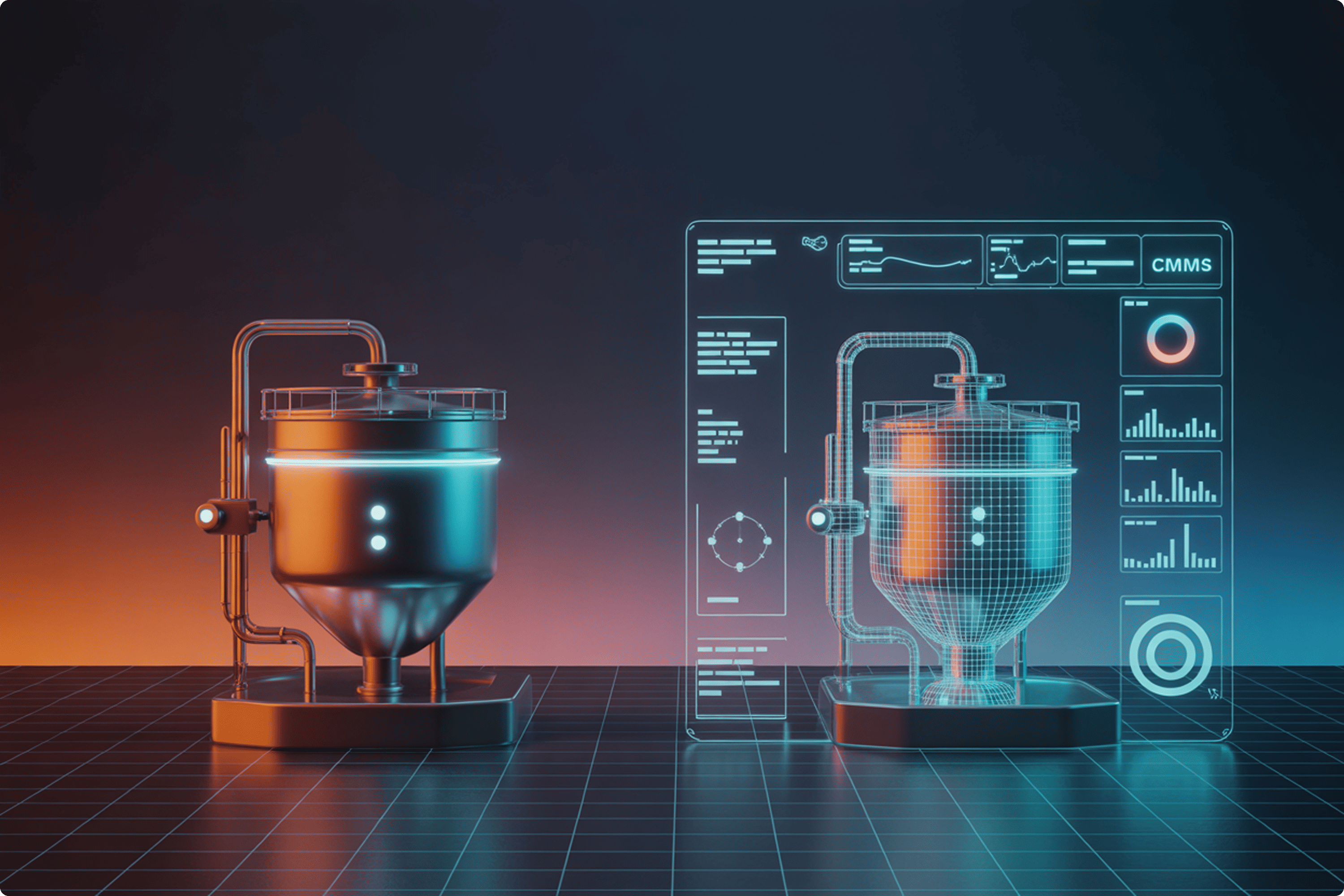Digital Twins in Manufacturing: From Concept to Implementation
How to build production-ready digital twin systems for industrial equipment, integrate them with existing CMMS/EAM platforms, and achieve 40-60% reduction in unplanned downtime through virtual simulation and predictive insights.

TL;DR
Digital twin technology creates virtual replicas of physical manufacturing assets, enabling real-time monitoring, predictive maintenance, and process optimization without disrupting production. Leading manufacturers report 35-50% faster troubleshooting, 25-40% reduction in maintenance costs, and 15-20% improvement in overall equipment effectiveness (OEE). However, 64% of digital twin projects fail to move beyond pilot phase due to integration complexity, data quality issues, and unclear ROI metrics.
Highlights
- Start with high-value assets where downtime costs exceed £50K per incident and sensor infrastructure already exists
- Choose between physics-based models for accurate simulation or data-driven models for pattern recognition and anomaly detection
- Build MVP digital twins in 10-14 weeks by integrating existing SCADA, CMMS, and IoT data before investing in new sensors or simulation software
Introduction
At Siemens’ Amberg Electronics Plant, production lives in two worlds — one physical, one digital. Before a single part moves on the line, engineers simulate every operation in a virtual replica of the factory. During one test, the twin revealed a hidden conveyor bottleneck that would have cost €2.3 million in lost output. The issue was fixed before any real machine stopped. Today, Amberg operates at 99.9988% quality, with over 75% of processes fully automated.
Few manufacturers reach that level of digital maturity. According to Gartner’s 2024 IoT survey, only about one in three companies that began digital twin initiatives in 2022 succeeded in deploying them beyond the pilot stage. The rest remain stuck — proof-of-concepts that look impressive in demos but never scale to daily operations.
The problem isn’t a lack of technology. It’s the absence of a structured, integrated approach. Successful implementations hinge less on advanced simulation software and more on how well existing systems — SCADA, CMMS, EAM, and IoT — communicate and share data in real time.
You don’t need a full-factory replica or a multi-million-pound platform to start. The key is focus: select the right assets, connect the data you already collect, and build a minimal viable twin that proves measurable ROI. This guide shows how to do exactly that — based on results from automotive, pharmaceutical, and heavy-industry deployments.
Ultimately, three early decisions determine whether your twin becomes a scalable success or another shelved pilot: which assets you model first, whether to use physics-based or data-driven methods, and how tightly your twin integrates with existing maintenance workflows.
Why Traditional Monitoring Falls Short
Walk into most manufacturing facilities and you’ll find SCADA systems, PLCs, and inspection schedules. Temperature readings. Pressure gauges. Vibration monitors. All showing current state.
Here’s what they don’t show: what comes next.
That bearing running at 75°C? Perfectly normal operating temperature. Also 48 hours from catastrophic failure because lubrication is breaking down in ways your threshold alarms can’t detect.
Traditional monitoring is fundamentally reactive. Something’s wrong? Condition monitoring tells you. Calendar says it’s time? Preventive maintenance kicks in, replacing parts that might have run another thousand hours. Neither approach answers the question that actually matters: “What’s this asset going to look like in a week, and what do we do about it?”
Digital twins promise to solve this. Virtual replicas that simulate equipment behavior, predict future states, test interventions before you touch the real hardware. Deloitte’s 2024 survey shows manufacturers expecting 30-50% downtime reductions and 20-35% maintenance cost cuts.
Implementation reality looks different.
The Integration Complexity Trap
Digital twin projects die because they require systems that were never meant to talk to each other. Your SCADA historian logs time-series sensor data. Your CMMS tracks work orders and maintenance schedules. Your EAM system manages asset hierarchies and financial data. CAD holds equipment geometry. MES knows production schedules.
The twin needs all of it. Synchronized. Contextualized. Available instantly.
A UK automotive manufacturer spent 18 months on a paint shop twin. The simulation accurately modeled paint thickness and curing times — beautiful engineering work. But it couldn’t pull real-time data from their MES or create work orders in the CMMS. The twin became a demonstration tool for facility tours. After £1.8 million invested, they shelved it.
Data format incompatibilities kill projects. SCADA outputs OPC-UA while CMMS expects REST APIs. Time resolution mismatches — sensors logging every second while maintenance records update daily. Missing context — high vibration readings that don’t account for the asset having just been started up. No bidirectional flow — the twin predicts a failure but can’t automatically schedule the repair.
Then there’s model selection paralysis. Physics-based twins use first principles—thermodynamics, fluid mechanics, structural analysis. Extremely accurate, but they demand deep engineering expertise and significant computational resources. Data-driven twins learn from historical sensor patterns using machine learning. Faster to build, though they need substantial training data and struggle with scenarios outside their experience. Teams debate this choice for months instead of just building something.
Digital twins are not about creating perfect virtual replicas — they’re about creating useful models that answer specific business questions. Start with the question, not the technology.
— Dr. Michael Grieves, Chief Scientist for Advanced Manufacturing
Digital Twin Architecture Types
Physics-based twins simulate how equipment actually works — heat transfer equations, stress-strain curves, flow dynamics. A gas turbine twin calculates combustion efficiency, blade thermal expansion, bearing loads based on operating conditions. These models predict behavior even in scenarios you’ve never seen before. They work for brand-new equipment with zero failure history.
Expect 16-24 weeks to build one. You’ll need domain experts and simulation packages like ANSYS or Simulink.
Data-driven twins take a different route. Feed them a year of sensor history and they’ll find patterns linking readings to equipment states without anyone explaining the physics. Train a pump twin on vibration, temperature, and flow data, and it learns to predict bearing wear and seal degradation on its own.
Eight to twelve weeks gets you a working model, assuming you have quality historical data and ML skills on your team. A pharmaceutical manufacturer built twins for 50 mixing vessels in 14 weeks, hitting 82% accuracy on maintenance predictions.
Hybrid twins combine both approaches. Physics models establish baseline behavior. Machine learning catches deviations and learns operational patterns the equations miss. Most production deployments end up here — physics handles well-understood failure modes, ML covers complex interactions and edge cases nobody thought about.
Integration Framework
Four data layers make a digital twin work:
Sensor layer pulls real-time telemetry from SCADA and IoT devices. Context layer brings in asset hierarchies from EAM and production schedules from MES. Analytics layer runs the twin models and simulation engines. Action layer pushes results into CMMS work orders, operator alerts, and sometimes back into control systems.
Industrial IoT platforms serve as integration middleware. Azure IoT Hub, AWS IoT Core, or on-premise solutions like Kepware handle protocol translation, time-series storage, API management. They connect OPC-UA from PLCs, Modbus from legacy equipment, REST APIs from enterprise software.
A European heavy equipment manufacturer cut integration time from eight months to six weeks using Azure Digital Twins as the bridge between shop floor systems and SAP EAM.
Minimum viable approach: Use only existing data sources initially. Connect your SCADA historian and CMMS through REST APIs. Build simple ML models predicting failure probability. Display alerts in dashboards people already use. Prove value before adding simulation engines or new sensors.
Watch: For a practical walkthrough of digital twin implementation, watch the tutorial What is a Digital Twin? Technology, Types, & How it Works.
Digital Twin Approaches Compared
| Approach | Best For | Accuracy | Performance & Notes |
| Physics-Based | New equipment, safety-critical assets | 90–98% | Build time: 16–24 weeks. Requires domain experts and specialized simulation software. High cost but extremely accurate. |
| Data-Driven (ML) | Equipment with rich sensor history | 75–88% | Build time: 8–12 weeks. Fast to deploy, but retraining required when conditions change. Struggles with unseen scenarios. |
| Hybrid | Production environments, complex systems | 85–95% | Build time: 12–18 weeks. Balances physics + ML accuracy. Complex to maintain; needs both engineering and data-science teams. |
| Rule-Based | Simple assets, clear failure thresholds | 60–75% | Build time: 4–6 weeks. Quick to implement but limited predictive capability and adaptability. |
Real Implementation Case
Automotive Press Line Digital Twin

Challenge: German supplier operated 12 stamping presses. Unplanned failures cost €120K per hour. Traditional maintenance replaced hydraulic components every 3,000 cycles regardless of condition.
Approach: Built hybrid digital twin combining physics-based hydraulic simulation with ML models. Integrated with SAP PM via REST API using Azure IoT Hub as middleware.


Results: Predicted hydraulic pump failures 5-8 days in advance with 87% accuracy. Extended component life from 3,000 to 4,200 cycles. Reduced unplanned downtime by 62%. Generated automatic work orders in SAP PM when twin predicted failure probability exceeded 75%. ROI: €840K investment paid back in 11 months.
Key lesson: Started with one press, proved the model, then scaled to all 12. Initial attempt to twin all presses simultaneously failed due to data quality variations.

12-Week Digital Twin MVP
| Week | Phase | Activities | Deliverables |
| 1-2 | Asset Selection | Identify 3-5 critical assets; audit sensors; map CMMS integration | Asset priority matrix, data assessment |
| 3-4 | Data Integration | Connect SCADA, CMMS, EAM via APIs; build time-series database | Unified data pipeline |
| 5-7 | Model Development | Build baseline twin; calibrate with historical data | Functioning twin model (70%+ accuracy) |
| 8-9 | CMMS Integration | Configure automatic work orders; set thresholds | Bidirectional CMMS-twin integration |
| 10-11 | Pilot Testing | Run in parallel; tune thresholds; gather feedback | Performance validation report |
| 12 | Production Launch | Deploy; train team; establish KPIs | Live digital twin with documented ROI |
Critical factors: Start with existing data before adding sensors. Integrate with CMMS from day one — twins that send email alerts get ignored. Define success metrics upfront: track prevented downtime, maintenance cost reduction, component life extension.
Pitfalls and Best Practices
Building twins without business case: Engineering teams build detailed simulations because they’re impressive, not because they solve expensive problems. Start with pain points costing >£50K annually. Calculate expected savings before writing code.
Ignoring data synchronization: Twins need time-aligned data from multiple sources. Use message queues (Kafka, RabbitMQ) for real-time streaming and event-driven updates.
Model drift: Twins degrade as equipment ages or operating conditions change. Implement continuous validation. Compare predictions against actual outcomes weekly. Retrain ML models quarterly. Monitor prediction error trends — sudden increases signal model drift.
No feedback loop: Twins that don’t integrate with daily workflows get ignored. Embed twin outputs directly into operator HMIs and maintenance dashboards. Provide clear actions (“Replace bearing in 5 days”) not raw predictions (“Failure probability: 0.73”).
Best practices: Version control twin models using Git or MLflow. Build twin hierarchies — start with components (motor, pump), aggregate to systems (cooling loop), then plant-level. Establish governance: define ownership, update frequency, and quality metrics.
Key Insights
- Asset selection drives ROI more than model sophistication. Twin assets where downtime exceeds £50K per incident and existing sensor infrastructure provides quality baseline data. Simple data-driven twins on critical equipment outperform physics-based twins on low-impact assets by 3-5x in cost-benefit.
- Integration with CMMS/EAM determines adoption rates. Digital twins that automatically generate work orders see 85% operator adoption. Twins requiring manual interpretation achieve only 20-30% sustained usage.
- Start with virtual simulation, scale to prediction. Fastest ROI comes from testing process changes virtually before physical implementation. Manufacturers report 4-6 month payback on simulation vs. 12-18 months for predictive maintenance twins.
Related Resources
How to Choose a Web Development Company in the USA — and Why the Market Is Evolving Faster Than Ever
Useful when your digital twin needs a web partner for CMMS/EAM integration and scalable dashboards.
Industrial IoT Sensors: Complete Guide to Smart Maintenance
Select and deploy the right sensor infrastructure to feed your digital twin systems.
Condition-Based Monitoring: Technologies and Best Practices 2026
Explore sensor technologies, monitoring strategies, and data collection methods that power effective digital twin systems.
Conclusion
Digital twins work. The numbers prove it — 35-50% faster troubleshooting, 30-40% less downtime, 15-20% better OEE. When implemented with clear business objectives and proper system integration.
Failure patterns are consistent: over-engineering, poor CMMS integration, starting with the wrong assets.
Speed wins. Organizations building minimum viable twins in 10-14 weeks and proving ROI on critical assets move faster than those pursuing comprehensive factory simulations. Begin with existing data infrastructure. Connect to current maintenance workflows. Add sophistication only where it demonstrably improves outcomes.
The 2026 landscape favors practical over perfect. Cloud platforms provide turnkey integration. Open-source simulation tools cut software costs. Pre-trained ML models accelerate development. Barriers to entry have collapsed.
Question isn’t whether digital twins work. It’s whether you’ll deploy them on your most expensive failure modes before competitors do. Virtual simulation and predictive capability are becoming baseline competitive requirements for manufacturing operations.